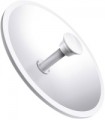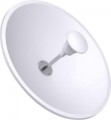Frequency range
The frequency ranges for which the antenna was originally designed. Communication technologies (see "Intended use") supported by the product directly depend on this parameter. At the same time, each type of communication includes several ranges, usually not compatible with each other. Therefore, when choosing a Wi-Fi or 3G antenna, it is worth considering not only the general purpose, but also the ranges within this purpose. Here are the most popular options:
—
2.4 GHz. The most popular band used by modern Wi-Fi equipment. It is standard for the Wi-Fi 802.11 b/g standard and one of the standard ones for the 802.11n standard. Supported by most appropriate antennas (see above).
—
5 GHz. The Wi-Fi band first introduced in the 802.11n standard (used in parallel with 2.4 GHz) and the only standard for 802.11ac, the most advanced Wi-Fi standard to date. Note that 5GHz-only equipment may not be compatible with older Wi-Fi 802.11 b/g devices; therefore, for guaranteed compatibility, it is recommended to combine a 5 GHz antenna with a 2.4 GHz one, or use a universal model that supports both bands (these are also available).
— CDMA 450. In general, the CDMA standard is known in the post-Soviet space for services such as "landline number on a mobile phone", as well as one of the most popular ways to "home" Internet connection via mobile networks (EV-DO technology is used). In this c
...ase, we are talking about CDMA communication using the 450 MHz band. Another popular band is 800 MHz; there is no fundamental difference between them, so both options are often used by operators within the same country and even region. However, CDMA450 and CDMA800 are not compatible with each other. Thus, before buying an antenna, you should definitely clarify which standard the selected mobile operator uses.
— CDMA 800. A CDMA communication standard using the 800 MHz band. See "CDMA450" above for details.
— GSM 900. GSM is a mobile communication standard that was extremely popular around the world some time ago. Today it is considered completely obsolete (primarily due to low bandwidth), it is gradually being replaced by more advanced 3G UMTS and 4G LTE formats. However, both of these formats are extensions of GSM, and such networks remain compatible with the original GSM equipment. In addition, inexpensive GSM modules are still used in some special devices that do not require high communication speed (alarm systems, payment terminals, etc.). Thus, antennas for this communication standard are still being produced. Specifically, GSM 900 (the numbers indicate the operating frequency in MHz) is the earliest GSM communication range that appeared in Europe and Asia. It is inferior to GSM 1800 in terms of energy efficiency and network capacity, but it has a longer range and works better in dense urban areas, which is why it is still used today. And even newer phones remain compatible with GSM 900.
— GSM 1800. The GSM range, created as a development and improvement of the GSM 900 described above, with a doubled operating frequency (up to 1800 MHz — hence the name). Due to this, it was possible to halve the radiation power, as well as increase the network capacity (the number of devices that can work in it simultaneously). On the other hand, GSM 1800 requires a denser arrangement of base stations, and the signal loses a lot of power when passing through walls. Therefore, devices with support for this range are made backward compatible with GSM 900.
— UMTS 2100. Standard range of mobile communication 3 generations (3G) of the UMTS standard. Usually, this connection is what they mean when they talk about a smartphone or tablet with 3G. Such networks have been deployed on the basis of the existing GSM infrastructure, however, due to the nature of the signal, UMTS requires antennas specially designed for this range.
In addition to those described above, modern antennas (primarily "mobile") may provide other ranges — for example, LTE 800, 1800, 2600 and 5G 700 MHz, 5G 3300 – 3800 MHz in models for the corresponding communication standard. However, this is extremely rare and usually as an adjunct to one of the more common options.
— LTE 800. One of the three most popular bands used by 4th generation LTE mobile communications in Europe and the post-Soviet space (although less popular than those described below). Also known as band 20, according to the official band numbering. Refers to the FDD format (see "Destination — 4G (LTE)").
— LTE 1800. The fourth generation mobile communication band, also known as band 3. Was the most popular in the world in 2016, and it is likely that this situation will continue for quite some time. In part, this popularity is due to the coincidence in frequencies with GSM 1800 and the ease of deployment of LTE networks in this range.
— LTE 2600. Another common 4th generation communication range; the second most popular, after LTE 1800, for 2016. According to the band table, it is called band 7. It is considered quite promising due to the very small amount of extraneous interference in its frequency band; many telecom operators are switching or planning to switch to LTE 2600 even despite the rather high cost of such a solution.
- 5G 700 MHz. One of the lowest bands for 5G networks, 700MHz has good indoor penetration and is suitable for high-speed mobile network deployments in rural areas and along highways. 5G on this frequency provides wide coverage outside major cities using fewer base stations.
- 5G 3300 - 3800 MHz. The main frequency range for the deployment of fifth generation mobile communication networks. It provides stable coverage in dense urban areas and a large number of subscribers.Gain
The signal gain provided by the antenna.
In this case, we mean the gain relative to an perfect isotropic radiator — an antenna that uniformly radiates a radio signal in all directions in the form of spherical waves. Such amplification is carried out by narrowing the flow of radio waves, roughly speaking, by increasing their concentration in space (even omnidirectional antennas emit waves not in the form of a sphere, but in the form of a disk). In this case, the coefficient is measured by the maximum power, which is achieved in the centre of the radiation pattern. Note also that the decibel is used to denote this parameter (more precisely, dBi, decibel relative to the isotrope). This is a non-linear unit: for example, a difference of 3 dB corresponds to a difference of approximately 2 times, 10 dB — 10 times, 20 dB — 100 times, etc. There are tables and calculators that allow you to convert decibels to times.
All this means that the gain is a rather specific parameter, and when choosing its optimal value, consultation with special sources or a professional communications operator may be required. However, this is true primarily for specific situations — for example, installing a 3G antenna in a private house a few kilometers from the base station. The general rule is this:
an increase in the gain has a positive effect on the communication range, however, it makes the antenna more susceptible to interference and, usuall
...y, affects its dimensions and weight.Connector
The type of connector, as well as its number, used to connect the antenna to a router, modem or other equipment.
—
N-connector. A coaxial connector with a characteristic round shape, developed back in 1940, known primarily as a standard socket for connecting antennas to a TV. However, in Wi-Fi and 3G equipment, a 50 Ohm impedance connector is used — it has a thinner centre contact than the 75-ohm "television" one, despite the fact that otherwise both connectors are identical. This is not a problem if the antenna is connected to external network equipment with a “native” cable, however, when using third-party wires, care must be taken: when connecting different types of connectors, they may be damaged, despite the fact that the connectors themselves are not always marked. However, this is also not recommended for electrical reasons (see "Characteristic impedance").
—
RP-TNC. A high-frequency connector that appeared somewhat later than the N-connector described above (in the late 1950s). Similar to it in size, it also has a coaxial design, but it is regularly made for a wave impedance of 50 Ohms, which made it convenient for Wi-Fi and 3G equipment. (There are also 75-ohm versions, but they are rare and have obvious differences from the standard ones).
—
RP-SMA. A further development of coaxial high-frequency connectors created in the 1960s
.... Like RP-TNC, it is standardly produced for a nominal resistance of 50 Ohms, but it is more miniature (almost 3 times smaller in diameter), which makes it well suited for compact routers and modems. At the same time, despite its small size, it provides a completely reliable and high-quality connection.
— MMCX. Coaxial antenna connector, which is small in size — the inner diameter of the socket is slightly more than 2.5 mm. Due to this, such connectors are widely used in various portable equipment. MMCX are designed for impedance of 50 ohms and frequency range of 0 – 6 GHz.
— TNC. The "original version" of the RP-TNC described above; appeared first, and later RP-TNC was created on its basis. Both interfaces are identical in size and general design of the connectors, but they have opposite polarity and a different distribution of contacts: in TNC, the “male” (male) contact is located on the plug, “mother” (female) is in the socket, in RP-TCN — vice versa. For a number of reasons, RP-TNC turned out to be more preferable for Wi-Fi and 3G equipment, and the original TNC was not widely used.
— FME. 50 ohm coaxial interface similar in size to RP-TNC but not identical. It supports frequencies up to 2.4 GHz, which is why it is found mainly in antennas for mobile communications and universal models.
— CRC9. Miniature coaxial interface, found mainly in 3G / LTE modems and antennas for them; however, it can also be installed in universal antennas. The connector diameter is only about 2 mm, which makes it easy to use in portable equipment. The cable under CRC9 often has an L-shaped plug to increase reliability.
